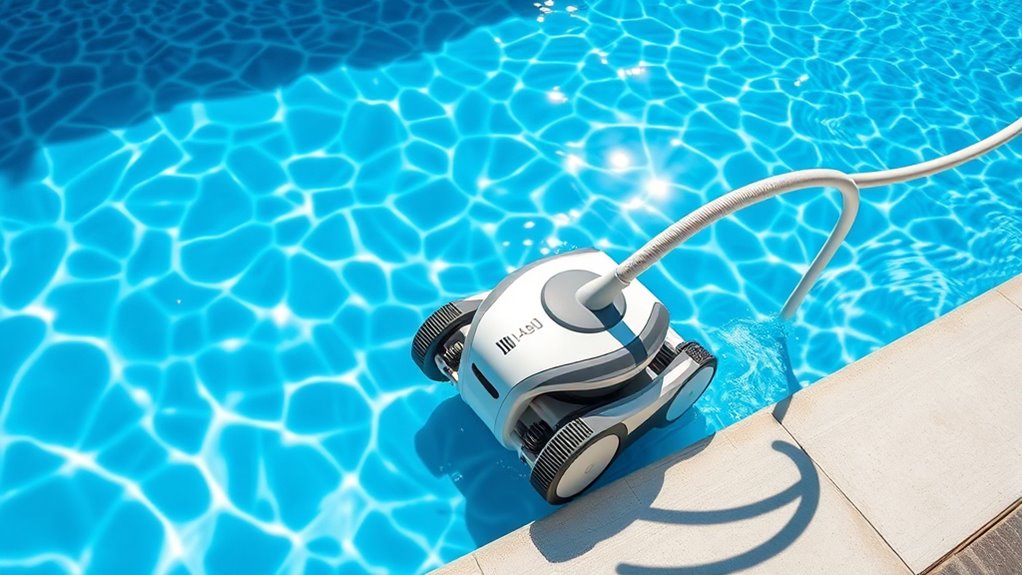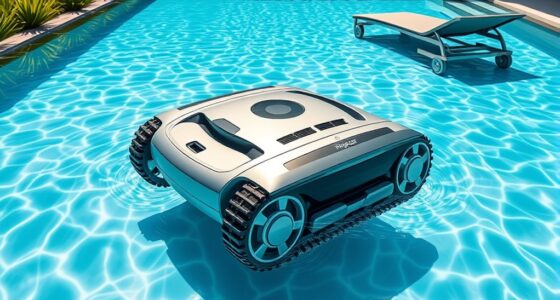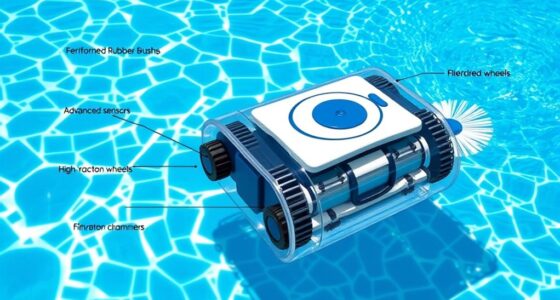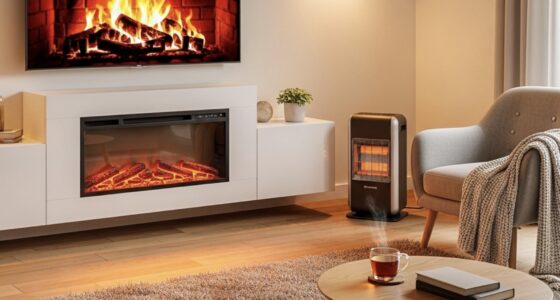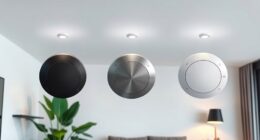To maximize your suction pool cleaner’s efficiency, choose the right size and type for your pool, and position it near main drains or skimmers. Regularly check and clean baskets, maintain proper water levels, and tweak return jets to improve circulation. Set a consistent cleaning schedule and troubleshoot issues promptly. Using the correct settings and storing your cleaner properly also extend its lifespan. Keep going, and you’ll discover more helpful tips to keep your pool spotless.
Key Takeaways
- Select the right cleaner size and type based on your pool’s shape, size, and debris load for optimal coverage.
- Properly position and anchor the cleaner near main drains or skimmers to maximize suction and cleaning efficiency.
- Maintain optimal water levels and adjust return jets to improve water circulation and prevent cleaner stagnation.
- Establish a consistent cleaning schedule and monitor operation to promptly address issues and ensure thorough cleaning.
- Regularly inspect and store components properly to prevent wear, extend lifespan, and keep the cleaner functioning effectively.
Choose the Right Size and Type of Cleaner for Your Pool
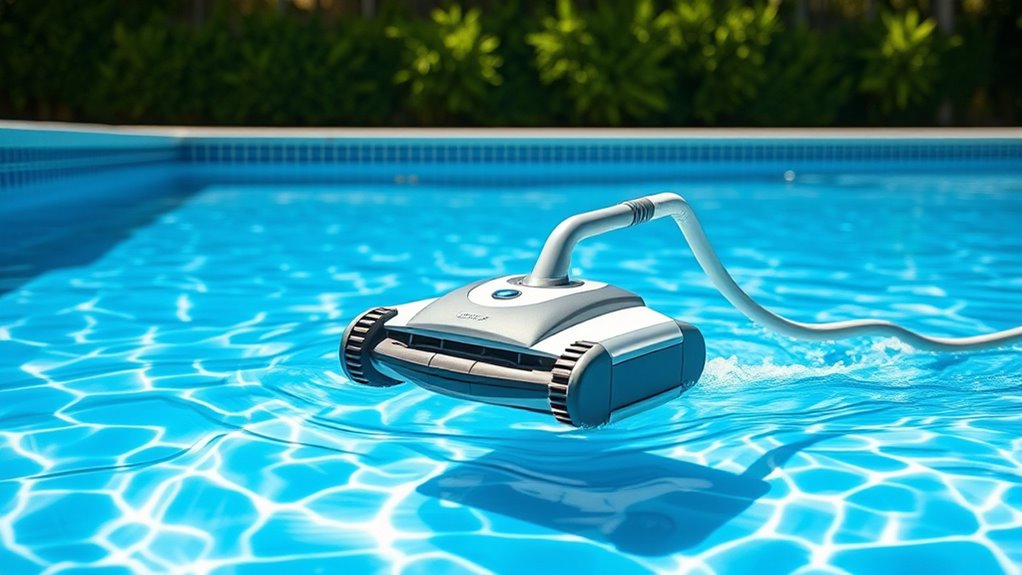
Choosing the right size and type of suction pool cleaner is essential to guarantee efficient cleaning and avoid unnecessary costs. Your pool size determines which cleaner type will work best; larger pools often need more powerful or larger models, while smaller pools can use compact, lightweight units. Consider the cleaner type: some are designed for above-ground pools, while others suit in-ground pools with complex shapes or multiple skimmers. Selecting a cleaner that matches your pool size ensures thorough coverage without overworking the device or wasting energy. If you choose a cleaner that’s too small, it may struggle with debris or coverage. Conversely, a too-large cleaner could be inefficient or hard to maneuver. Matching the cleaner size and type to your pool’s specifications is key for effective, long-lasting cleaning. Pool size plays a crucial role in determining the most suitable cleaner, helping to optimize performance and lifespan. Additionally, understanding smart technology integration can further enhance your pool cleaning efficiency by providing remote monitoring and control options. Properly sizing your cleaner can also extend its operational lifespan, saving money over time, and selecting a model with energy-efficient features can reduce ongoing operational costs. Incorporating regular maintenance routines can further ensure the longevity and optimal performance of your cleaner over its lifespan.
Properly Position and Anchor the Cleaner for Optimal Coverage
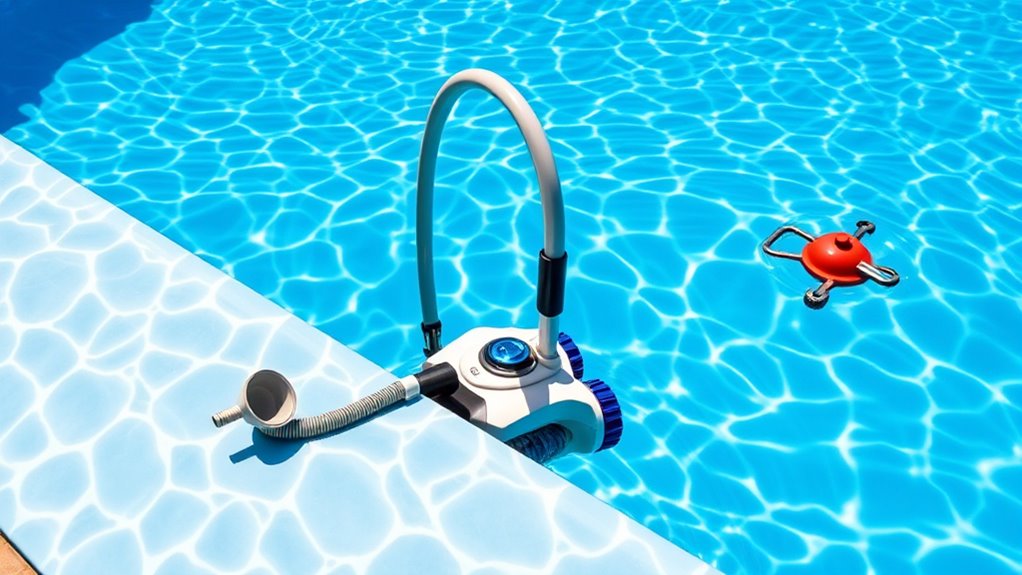
Start by selecting strategic spots where your cleaner can begin its work efficiently. Make certain to secure it with stable anchors to prevent shifting during operation. Cover all pool areas to ensure thorough cleaning and prevent missed spots. Additionally, regularly inspecting and maintaining your pool cleaner can improve its efficiency and longevity. Properly positioning your cleaner can significantly reduce energy consumption and enhance cleaning performance, minimizing the environmental impacts of improper setup. A clear understanding of your navigation technology can help optimize its path and cleaning coverage. Moreover, understanding the Volkswagen Tuning market can help you choose compatible parts and tuning options that maximize your vehicle’s performance and efficiency. Additionally, being aware of regional resource availability can assist in accessing the necessary tools or replacement parts to maintain optimal operation.
Choose Strategic Placement Spots
To guarantee your suction pool cleaner covers the entire pool efficiently, you need to carefully select its placement spots. Start by choosing areas where the cleaner can easily access the pool surface without obstructions. Place it near the main drain or skimmer to maximize suction power and ensure thorough cleaning. Avoid spots cluttered with obstacles or debris that could hinder obstacle navigation. Position the cleaner where it has a clear path across the pool surface, allowing it to move freely and cover more area. Rotating its placement periodically helps prevent the cleaner from getting stuck in one spot. Additionally, understanding the efficient operation of your cleaner can help you optimize its performance and prolong its lifespan. Being aware of the tuning options available for your pool equipment can further enhance the overall efficiency of your pool maintenance routine. Regularly inspecting the cleaner’s brushes and filters ensures optimal functionality and prevents breakdowns. Incorporating a performance monitoring routine can also help identify issues early and maintain peak cleaning efficiency. Furthermore, consulting the best equipment practices can lead to better maintenance and longer-lasting equipment.
Secure With Stable Anchors
Securing your suction pool cleaner with stable anchors is essential for achieving consistent coverage. Properly using pool anchor points guarantees the cleaner stays in place and maintains a secure attachment to the pool surface. Start by identifying sturdy anchor points around your pool, such as fixed ladders or designated anchor spots. Attach the cleaner’s cord securely to these points, preventing it from drifting or tangling. A secure attachment allows the cleaner to move systematically across the pool, cleaning efficiently without getting stuck or lost. Regularly check the anchors and attachment points for stability, especially after storms or heavy use. Additionally, using vetted anchors designed specifically for pool cleaning equipment can improve reliability and durability. By ensuring your cleaner is well anchored, you optimize its movement and overall cleaning performance, saving you time and effort on pool maintenance.
Cover All Pool Areas
Ensuring your suction pool cleaner covers every area requires careful positioning and anchoring. To achieve thorough pool wall scrubbing and algae removal, place the cleaner strategically to reach all corners and surfaces. Make sure it’s anchored securely to prevent it from drifting away, especially along the walls. Adjust its position regularly to avoid missed spots and ensure consistent coverage. Proper placement helps the cleaner access hard-to-reach areas, maximizing efficiency. Incorporating automation technologies can further improve cleaning patterns and effectiveness. Additionally, understanding the pool surface types can help optimize the cleaner’s performance and longevity. Regularly inspecting the cleaner’s components ensures it operates smoothly and maintains optimal coverage.
Regularly Check and Clean the Skimmer and Pump Baskets
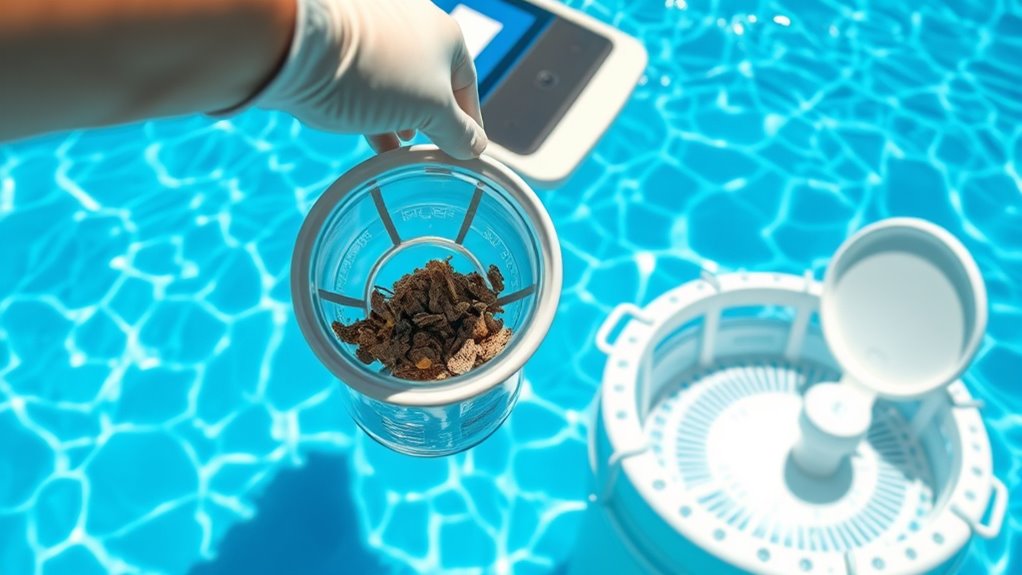
Regularly checking and cleaning the skimmer and pump baskets keeps your pool’s filtration system running smoothly. Skimmer maintenance involves removing leaves, debris, and dirt from the skimmer basket to ensure proper water flow and prevent clogs. Pump basket cleaning is equally important; it prevents blockages that could strain your pump or reduce suction power. Make it a habit to inspect these baskets weekly, especially during heavy use or windy days. Empty and rinse out debris thoroughly to maintain ideal filtration. A clean skimmer and pump basket help your suction pool cleaner operate efficiently, reducing strain on the system and prolonging its lifespan. Consistent maintenance is simple but essential for keeping your pool clean and your equipment functioning at its best.
Maintain Correct Water Levels for Effective Operation
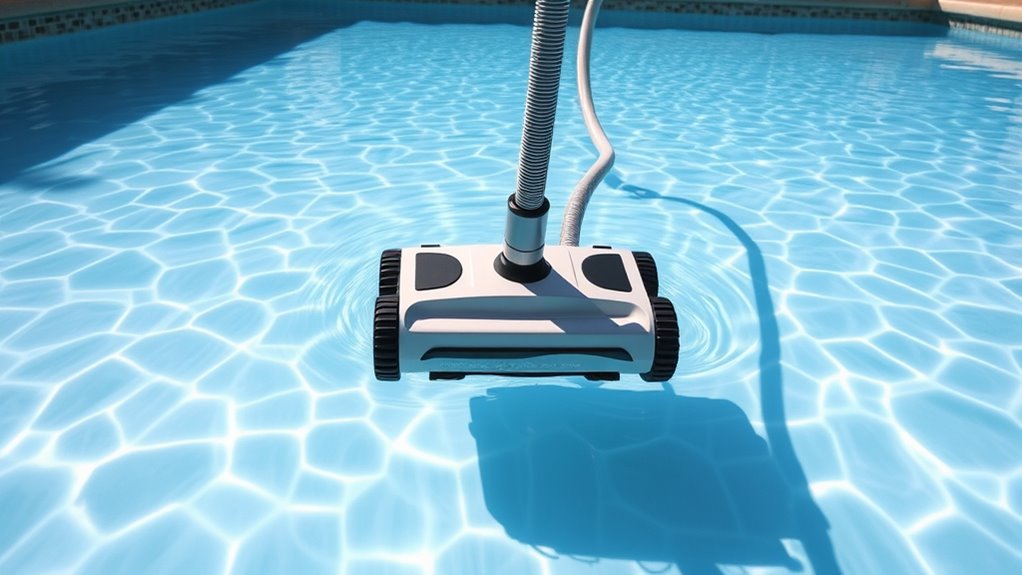
Keeping the water level just right is key to your cleaner’s performance. You should check it regularly and make adjustments when needed. Avoid overfilling or underfilling to guarantee your pool cleaner works smoothly. Additionally, ensure the water level is appropriate for effective operation, as improper levels can hinder the cleaner’s ability to function properly. Proper water levels also help prevent damage to the headphones, ensuring a longer lifespan and optimal performance. Maintaining the correct water level supports the father-daughter bond, as a well-functioning pool can be a source of family enjoyment and shared moments. Regularly monitoring water levels can also reduce the risk of remote work burnout, by providing a peaceful environment that promotes relaxation and focus. For optimal cleaning, consider how culinary uses of chia seeds demonstrate the importance of proper preparation and ingredient balance, much like maintaining correct water levels ensures your pool’s efficiency.
Check Water Level Regularly
Since water levels directly impact your suction pool cleaner’s ability to operate effectively, it’s important to check them frequently. Maintaining proper water levels ensures consistent suction and prevents damage to the cleaner or pool equipment. When testing your water, focus on chemical balancing to avoid cloudiness or algae growth that can hinder cleaning. Regularly monitor the water level, especially after heavy rain or pool usage, to keep it within the recommended range. Proper water balance also supports overall pool health and prolongs equipment lifespan by reducing corrosion and buildup. Additionally, ensuring compliance with fire safety standards when installing and maintaining pool equipment can prevent potential hazards.
Adjust Water Level Properly
Have you ever noticed how a slight change in water level can affect your pool cleaner’s performance? If the water level drops too low, your pool skimming might become less effective, and the cleaner could lose suction. Conversely, overfilling can cause the cleaner to struggle with movement and reduce its ability to pick up debris efficiently. To maintain ideal operation, adjust the water level so it’s roughly halfway up the pool’s skimmer opening. This ensures the suction remains consistent and the pool skimming stays effective. Proper water levels help your suction pool cleaner work smoothly, avoiding interruptions and ensuring thorough cleaning. Regularly check and adjust the water level as needed to keep your cleaner functioning at its best.
Avoid Overfilling or Underfilling
To guarantee your suction pool cleaner works effectively, it’s essential to avoid overfilling or underfilling the pool. Incorrect water levels can disrupt the cleaner’s suction, reducing its efficiency. Maintaining proper water height helps preserve the pool’s water balance and chemical levels, preventing issues like algae growth or equipment strain. Regularly check the water level to ensure it’s at the recommended mark.
- Keep the water level aligned with the skimmer opening
- Avoid adding too much water after rain or top-offs
- Drain excess water if levels become too high
- Test and adjust chemical levels regularly
- Maintain proper pool water balance for ideal cleaning performance
Adjust Your Pool’s Return Jets to Improve Movement
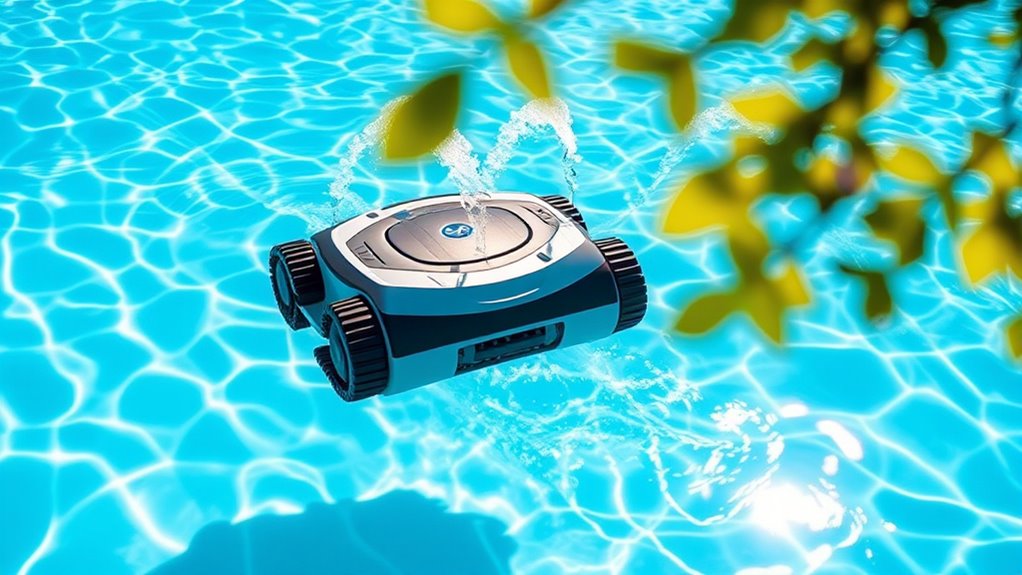
Adjusting your pool’s return jets can considerably enhance your suction pool cleaner’s movement. Proper return jet alignment directs the water flow to create better circulation, helping the cleaner reach all areas of your pool. By tweaking the flow adjustment, you can prevent the cleaner from staying in one spot or missing sections. Aim the jets to promote smooth, consistent movement, especially in corners and along walls. To do this, observe how the cleaner moves and adjust the jets accordingly, ensuring the water flow pushes it in the desired direction. Small changes in return jet alignment can make a significant difference in cleaning efficiency. Regularly check and fine-tune these settings to keep your cleaner moving effectively and cover your entire pool surface.
Set a Consistent Cleaning Schedule to Cover All Areas
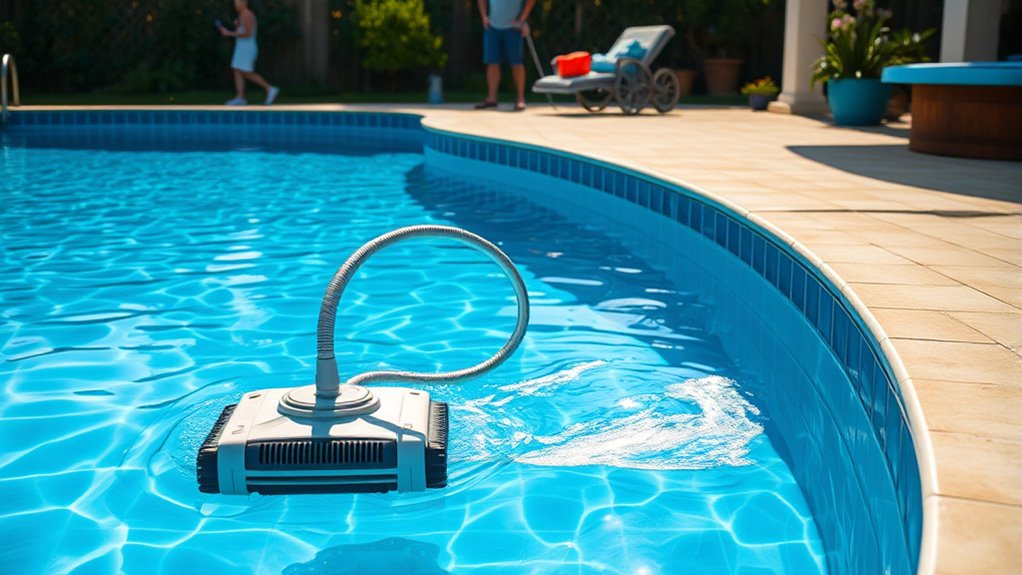
Establishing a consistent cleaning schedule guarantees your suction pool cleaner methodically covers every area of your pool. Regular cleaning ensures the entire pool surface stays clean and reduces debris buildup. By sticking to a set cleaning frequency, you prevent missed spots and uneven wear on the cleaner. Consistency also helps maintain water quality and reduces algae growth. To maximize efficiency, consider these key points:
- Schedule cleanings during low-traffic times for better coverage
- Adjust frequency based on pool usage and debris levels
- Rotate cleaning times to avoid pattern neglect
- Monitor your pool’s surface for any missed spots
- Stay committed to your schedule for ideal results
A steady routine guarantees thorough cleaning and a pristine pool surface.
Monitor and Troubleshoot Common Issues During Cleaning
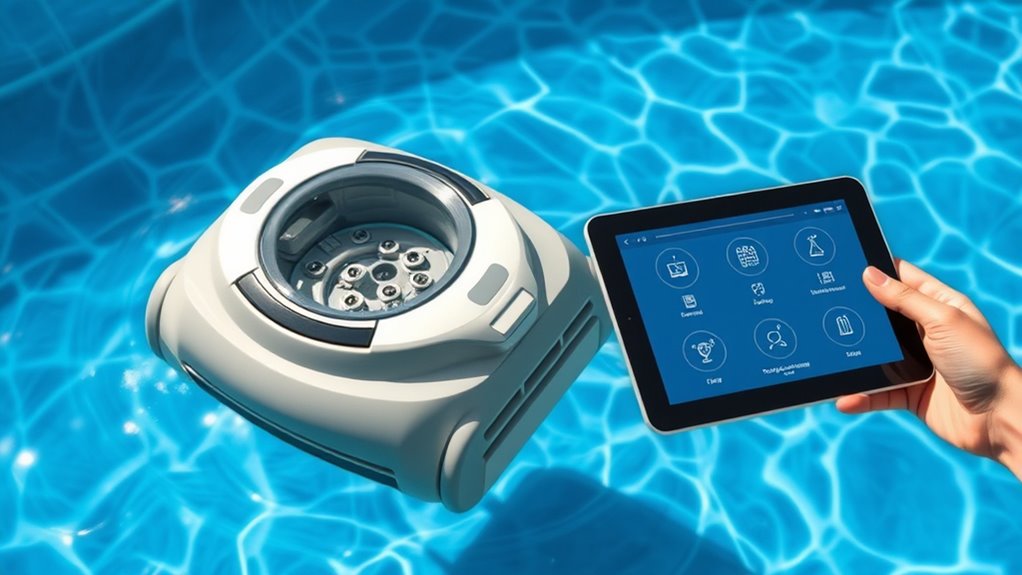
Monitoring your suction pool cleaner during each session helps catch issues early, preventing incomplete cleaning and potential damage. Keep an eye on sensor calibration, ensuring the sensors accurately detect pool walls and obstacles. If the cleaner isn’t steering properly or seems stuck, recalibrate the sensors to restore optimal performance. Pay attention to debris detection; if it’s missing larger debris or getting clogged, it may indicate a need for cleaning or adjusting the filter. Regularly observe the cleaner’s movement and suction strength. Troubleshoot common issues like uneven cleaning, strange noises, or reduced suction by inspecting for blockages or debris buildup. Promptly addressing these problems keeps your cleaner running efficiently and extends its lifespan.
Use the Correct Settings and Attachments for Different Debris Types
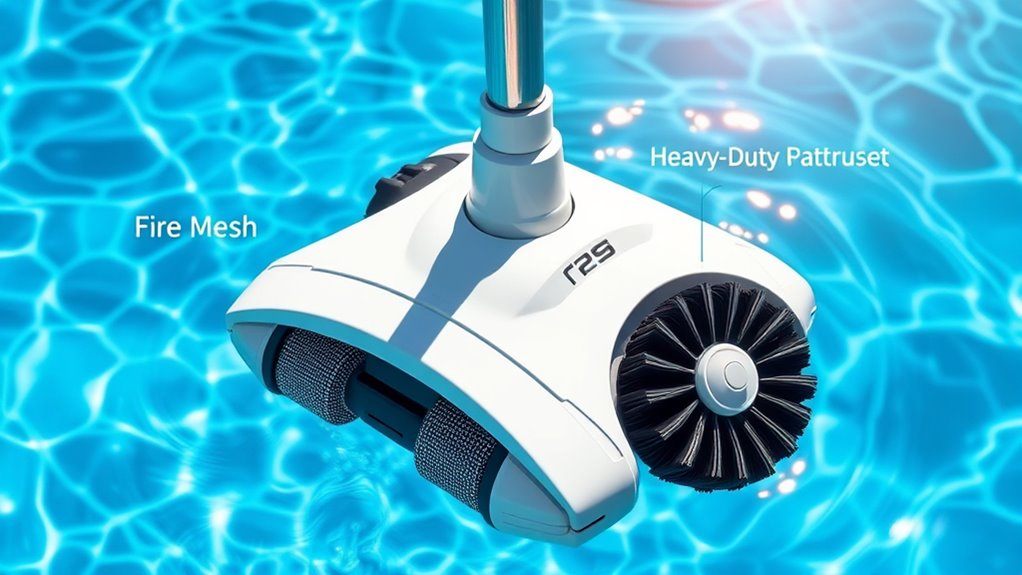
Using the correct settings and attachments guarantees your suction pool cleaner handles different debris efficiently. Adjust the cleaner’s speed and suction power based on debris types, like leaves, dirt, or small particles. Choose attachment options suited for specific debris, such as a wide-mouth head for large debris or a finer brush for algae. Properly switching attachments ensures thorough cleaning without clogging or unnecessary wear.
- Match attachment options to debris size and type for ideal results
- Increase suction for heavy debris like leaves and twigs
- Use finer brushes or filters for algae and small particles
- Adjust settings for delicate surfaces or fine debris
- Regularly check and change attachments to prevent blockages and maintain efficiency
Store and Maintain Your Cleaner for Longevity and Performance
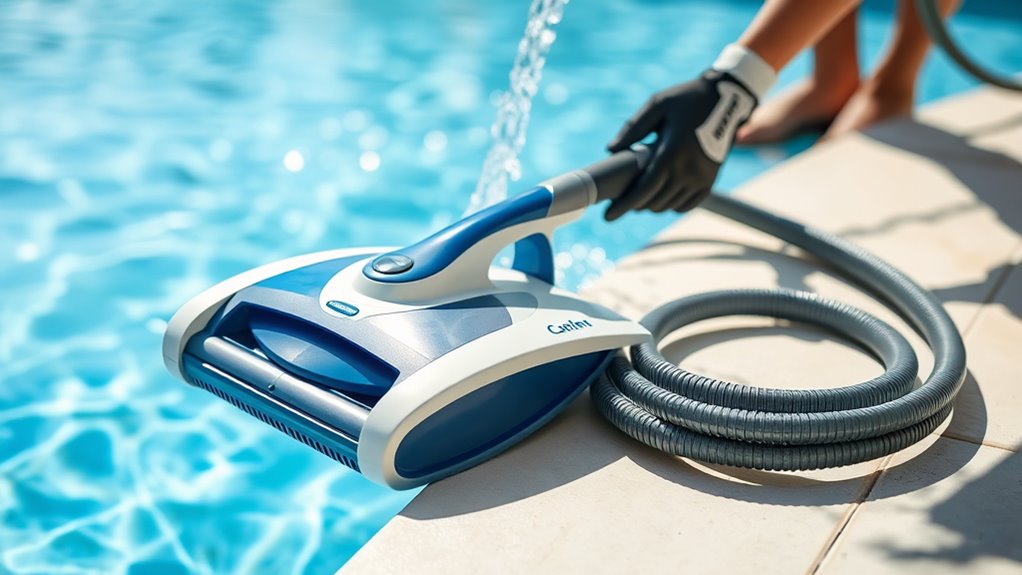
Proper storage and regular maintenance are essential to keep your suction pool cleaner performing at its best and extending its lifespan. To do this, follow simple storage tips, such as rinsing the cleaner thoroughly after each use and storing it in a cool, dry place away from direct sunlight. Before storing, check your maintenance checklist to ensure all parts are clean and free of debris. Inspect hoses and brushes for wear, and replace any damaged components. Properly draining and drying your cleaner prevents mold and corrosion. Keeping your cleaner stored properly and performing routine maintenance helps maintain ideal performance, reduces the risk of breakdowns, and prolongs its lifespan. Staying consistent with these practices maximizes your cleaner’s efficiency year after year.
Frequently Asked Questions
How Can I Improve Suction Power if My Cleaner Isn’T Working Well?
If your suction pool cleaner isn’t working well, start by checking the filter and cleaning it if it’s clogged. Inspect the hose for leaks, cracks, or blockages that could reduce suction. Make sure the hose connections are secure and free of obstructions. Regular filter maintenance and hose inspection will help restore peak suction power, ensuring your cleaner works efficiently and keeps your pool sparkling clean.
What Safety Precautions Should I Follow When Operating the Pool Cleaner?
When operating your suction pool cleaner, prioritize pool safety by keeping the area clear of obstacles and guaranteeing the power cord is secure to prevent tripping. Always follow proper operator training, such as reading the manual thoroughly and wearing gloves if needed. Turn off the cleaner before handling or adjusting it, and never leave it unattended during operation. These precautions help protect you and ensure the cleaner functions effectively.
Can I Use My Suction Cleaner During Pool Chemical Treatments?
You can’t really have your cake and eat it too when it comes to using your suction cleaner during chemical treatments. It’s best to check chemical compatibility first, as some chemicals can damage your cleaner. To keep everything running smoothly, wait until your pool’s chemical levels stabilize before running your cleaner. Stick to your cleaning schedule, and you’ll avoid issues and keep your pool sparkling and safe.
How Do I Troubleshoot if the Cleaner Gets Stuck Frequently?
If your suction pool cleaner gets stuck often, start by checking the sensor calibration to guarantee it’s working correctly. Make sure there are no obstacles blocking its path; remove any debris or objects that might trap it. Also, inspect the wheels and brushes for damage. Proper calibration and obstacle removal help your cleaner move smoothly, preventing frequent getting stuck and keeping your pool spotless efficiently.
Is It Necessary to Remove the Cleaner After Each Use?
Think of your pool cleaner as a trusty tool that needs gentle care. You don’t have to remove it after each use, but a good maintenance routine helps it last longer. Store it properly with dry, clean parts to prevent damage. Follow storage tips like rinsing off debris and checking for wear. This way, your cleaner stays ready, efficient, and ready to keep your pool sparkling every time you need it.
Conclusion
With these tips, your suction pool cleaner will become an unstoppable force of cleanliness, transforming your pool into a sparkling oasis in no time. Say goodbye to tedious scrubbing and endless manual labor—your cleaner will conquer dirt, debris, and grime like a superhero on a mission. Once you master these strategies, you’ll wonder how you ever managed without this powerful, efficient cleaning hero. Get ready to enjoy crystal-clear waters and a pool that dazzles everyone who sees it!
